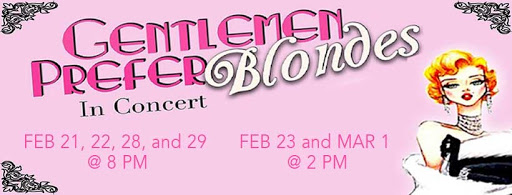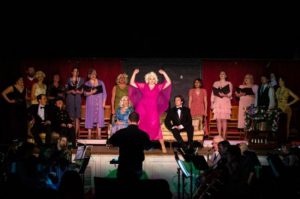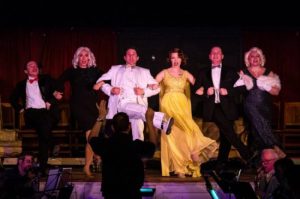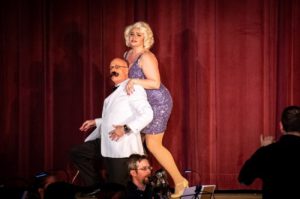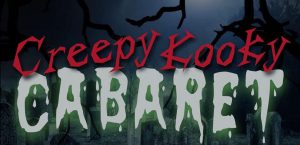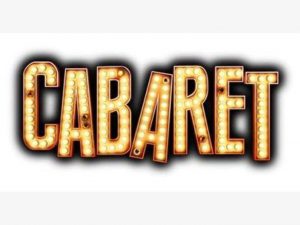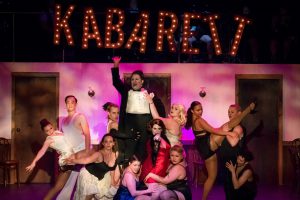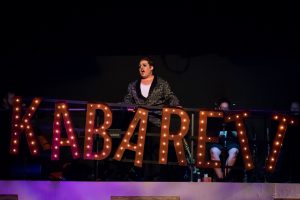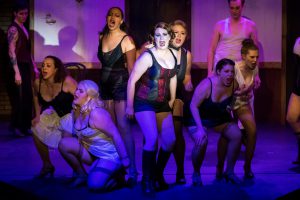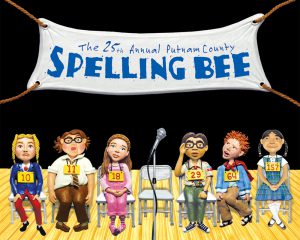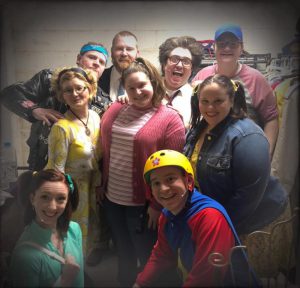By Mark Briner

In the 2001 Tony season, Mel Brooks made history and swept the evening with a (then) record number of fifteen nominations and a (standing) record of twelve wins including Best Musical, Best Score, Best Book, Best Direction, and 3 of the four Best Performance awards (only because there was no leading actress role to nominate) with his musical adaptation of his early hit movie The Producers. What better way to follow up the momentum but to announce that Brooks’ next project would be adapting what he considered his personal best movie for the musical stage? Silhouette Stages latest offering, Young Frankenstein, with a Book by Mel Brooks and Thomas Meehan and Music & Lyrics by Mel Brooks, Directed and Choreographed by Tommy Malek, and Musical Direction by Nathan C. Scavilla, couldn’t be anything but a monster hit!
The transition of Young Frankenstein seemed to be problematic in ways his inaugural attempt wasn’t. The project seemed to suffer under the weight of the movie’s success. The Producers was a story about deliberately writing a bad musical for illicit financial gains, and Brooks’ original score of schlocky, borscht belt inspired ditties worked perfectly and added an extra layer of goofy parody onto the material. However in Young Frankenstein, he had to overcome the shadow of an ideal screenplay (inspired by and co-authored with star collaborator Gene Wilder), a virtual perfect scene by scene parody of the original Frankenstein and Bride of Frankenstein screen classics, and arguably the most definitive and iconic casting ever achieved in a single film.

“Life, Life” Credit: Mort Shuman Photography
His movie wasn’t just a success, or merely a film with huge cult following, it stands as one of the most flawless comic experiences ever filmed. Subsequently his 2007 premiere of the musical met with the antithesis of his previous critical glorification. First, a musical should elevate its core material by the addition of music to justify its incarnation. Brooks and Wilder’s original screenplay is already razor sharp in its streamlined execution of both broad and subtle jokes, and a flawless parody of its subject. His music in most instances just slows the plot to a halt. The actors in the movie make maximum efficiency of their screen time with exquisite and unique comic timing, setting up and dropping rapid fire, nonstop jokes with sharpshooter precision, then move onto the next one. Their counterparts in the musical, by contrast nail a punchline, then stop the narrative to sing about it for three minutes.
Secondly, there’s the issue of the music itself. Brooks’ amateurish compositions actually added to the humor of
The Producers. But in
Young Frankenstein, while there are some numbers that land well like “Together Again (for the First Time)” a comic vaudevillian duet between Frederick Frankenstein and new assistant Igor, and “Transylvania Mania”, a hilarious first act finale number led by Igor to hide the existence of the Monster from the townsfolk who haven’t forgotten history, most stand out (or more accurately,
don’t stand out) as what would be considered throwaway numbers in other shows and last minute grabs from the trunk of
The Producers‘ leftovers (the
New York Post referred to it as a “ho-hummable” score). But the major prohibitive factor facing any production is the fact that if ever a movie was full of definitive performances, this cast with Brooks comic veterans Gene Wilder, Marty Feldman, Chloris Leachman, Kenneth Mars, Gene Hackman, and the incomparable Madeline Kahn define the term “definitive performances”. Every actor in every production sets foot on stage with a Herculean handicap of merely not being their predecessors.

Jeremy Goldman as Dr. Frankenstein and Students. Credit: Mort Shuman Photography
However, time has been kinder to the piece since 2007. It no longer lumbers under the umbrella of
The Producers, which has not aged well, showing it owes much if its success to its own stars
Nathan Lane and
Matthew Broderick. There is also (stab this reviewer in the neck immediately) a new generation that has not seen the movie and grown theatre kids that know the musical better. And with its original panning and some pretty bad excuses of musicals gracing the New York stage in the last decade, audiences can release their expectations and enjoy the many hilarious moments Brooks provides saluting his film triumph. Fortunately, this distance allows Silhouette Stages audiences to appreciate every entertaining aspect of their valentine to Brooks legacy.
It would normally be unfair and unethical to compare local actors to counterparts from a classic movie, but every audience member who has seen the movie will be doing just that subconsciously, so it is in this case relevant. For those who haven’t (if this pertains to you and you’re still reading–go, watch the movie! NOW!), well those people should be ashamed of themselves and don’t really add anything to this discussion, so, proceeding. Up front, full disclosure, this reviewer is one who counts the movie as one of his all-time favorites, and pretty perfect, with no room for variation and personal interpretation. It’s Brooks way or fail. Fortunately, the cast and team at Silhouette stage seem to understand this mindset completely and have provided a thoroughly entertaining, full color 3-D fleshed out tribute to all that is sacred in Brooks’ broad comic universe.
Director/choreographer Tommy Malek understands the film and its techniques completely. The movie being a spoof of the original 1930’s Universal classics, he provides preshow ambience by screening movie trailers of films of that era. A slick and unexpected touch is his addition over Brooks’ long and completely unnecessary overture (believe this reviewer, the score is no
Gypsy) of a series of filmed still credits for his production, the stars and production team billed in painstakingly perfect sendups of the film credit style of the day, in one stroke transforming the overture from lackluster to highlight. It is obvious early on that Malek has a thorough grasp on not only his original source material, but on how to adapt in into another medium theatrically. The performers are great and game for his hijinks, but for the gullible audience member who thinks that good actors jump on the stage and just bring the performance you see, know full well every performer in this show owes at least half of their success to Malek’s masterful hand saluting physical comedy, vaudevillian shtick, clowning double takes, over the top excess, and the power of the perfect comic pause. He pays ultimate tribute to the style and influence of Brooks at his best, but without imitating. Rather he filters his Brooks-ian homage through a cast of well-tuned instruments and, like the titular Dr. Frankenstein, bestows new energy and life into this potential monster of a show.

Jeremy Goldman, Lindsay Landry, and Matt Wetzel. Credit: Mort Shuman Phogography
And what well-tuned instruments he has at his disposal to create his comic virtuoso symphony. Led by Jeremy Goldman as Frederick, the cast delivers nonstop energy and fully embraces Malek’s comic vision. Goldman, operating under the weight that we have just lost his beloved counterpart Wilder, brings just the right touch of Wilder’s wacky straight man to the table, balancing deadpan pauses with instances of mania. He has the ability to be superior on the brink of arrogant one instant, madly frantic the next, and gently sympathetic the following. He is a perfect foil for all his comic costars to bounce off, while maintaining definite leading man charisma throughout. He generously gives to his fellow performers allowing them to outshine whenever the script calls for it, realizing that in the process, he comes out a stronger lead.

Matt Wetzel as Igor. Credit: Mort Shuman Photography
In the story, blundering but endearing assistant Igor steals an abnormal brain, but in the vehicle of Matt Wetzel, he also steals virtually every scene in which he appears. He and Goldman share a breezy stage chemistry rivaling Abbott and Costello or Laurel and Hardy. Wetzel has a tight rein on exactly how far to go with the physical bits (to Pittsburgh seems about right), grasping how to shine without outshining. He gives credit to
Marty Feldman‘s classic delivery when required (and without Feldman’s built in rubbery facial advantages) but also is capable of displaying his own personal strengths. Provided the bulk of Brooks’ physical comedy, Wetzel (quite literally) throws himself into those moments with relish and endearing flair. He also benefits from being handed the two best songs of the show, his clever faux Vaudevillian duet with Goldman, “Together Again (for the First Time)”, and the first act show stopper “Transylvania Mania” wherein he leads the company in a rousing Charleston attempting, with hilarious vocal riffs, to cover the newly roused Monsters guttural moans. He embraces both as golden opportunities to show his comic strong suit in moments where he is not hampered by Feldman’s shadow.

Lindsay Landry as Inga and Jeremy Goldman as Dr. Frankenstein. Credit: Mort Shuman Photography
Lindsay Landry embodies the role of Brook’s stock fantasy Bavarian blonde shiksa goddess, in this case laboratory assistant Inga. Miss Landry makes an impressive entrance in the back of a hay cart and shows off her vocal and comedic skills in a hilariously staged “Roll in the Hay”, a visual Brooks-style ode to her physical attributes, complete with mocked up choreographed horses. The number also gives her a chance to display mad yodeling skills, an opportunity not offered by many modern musicals. Some may consider Brooks handling of his ubiquitous blonde goddesses on the border of sexism these days, but Miss Landry gamely plays with the image and delivers an adept comic sweetness. At some points during her love duet with Frederick, “Listen to Your Heart”, she tends to come on a bit too aggressively (Brooks’ lustful “ingénues” tend to possess a very easy European open sexuality, so healthily ingrained in them that they effortlessly exude sex appeal as freely as they exhale, his standard sleep away camp fantasy of the unassuming blonde shiksa bombshell), but overall she instills Inga with
Terri Garr‘s requisite comic grace.

Jean Berard as Frau Brucher. Credit: Mort Shuman Photography
Jean Berard’s ghoulish housekeeper, Frau Blücher is a physically intimidating spiritual vacuum. Somber, stoic, and eerily devoid of any detectible human emotions, her cohorts (and the audience) share a little of the horses’ uneasiness in her presence. While she starts off slightly over-animated, allowing her voice to show a few too many vocal inflections, by the time delivers her introductory torch song, “He Vas My Boyfriend”, a mock Kurt Weill-ian ode to her unrequited love for Frederick’s grandfather Victor, she delivers it with the physical aplomb of an Amazonian Lotte Lenya. In this number she vocally settles into the rhythms of the character, understanding that Blücher (
neigh), like
Cloris Leachman‘s interpretation, registers best when delivered vocally deadpan in a Bea Arthur-esque baritone. Fortunately, Berard retains these qualities for the remainder of the show.

Michael Crook as Inspector Kemp and Villagers. Credit: Mort Shuman Photography
Written by Brooks in the musical to be a dual role,
Kenneth Mars‘ resident heavy Inspector Kemp and
Gene Hackman‘s sympathetic Blind Hermit were designed to be played by the same actor. Malek makes a decision to cast the roles separately, which fortunately allows Don Patterson a cameo scene to shine as the Hermit. After pleading in song “Please Send Me Someone”, his prayers are answered in the unseen form of the lumbering Monster that he mistakes for a mute. Patterson makes the best of all Brooks’ stock comic bits and instills the Hermit with an appealing humility. Michael M. Crook as Kemp delivers Brook’s stock neo-Nazi antagonist with all the crisp wooden blocking/choreography the physical humor calls for with his missing limbs.

Christopher Kabra as The Monster. Credit: Mort Shuman Photography
As the new Dr. Frankenstein’s latest Monster, Christopher Kabara gets the ultimate anticipatory lead entrance, being introduced just before his break out moment at intermission, and Kabara is worth the wait. Alternately scary and sweet, he lands big laughs as a creature of few words, but several hundred perfectly timed grunts, moans, and wails. Terrifying to the townspeople yet endearing in his quiet scene with the gentle blind man, he scores highest when asked to deliver an unlikely production number in the movie’s ultimate set piece, wisely secured by Brooks to keep intact for the musical, Irving Berlin’s “Puttin’ on the Ritz”. Kabara tap dances (stomps?) and uses his impressive physical stature to the max as we watch him exude momentary childlike exuberance finding the joy of musical theatre, and, like predecessor
Peter Boyle, his vocal mangling of the song’s lyrics never get old. He also adeptly turns the table when the story gives him a final twist that displays another side of Kabara’s acting prowess. The only critique of Kabara’s performance is a technical one. His green hued makeup as the Monster is expertly applied and enhances every one of his facial expressions. But the color stops at his jawline and, in lower collared shirts, his human flesh colored neck, a critical anatomical feature in a creature known for bolts and scars there, is visible, as are his pink hands both of which break the illusion he is so perfectly creating. Simply blending the facial color down his neck and under the costume line, as well as a thin tint on the backs of his hands up under the cuffs, would complete the illusion instead of visually distracting from it. Again, this was a final dress rehearsal, and perhaps his time was rushed and this will be easily corrected by opening night.

Ashley Gerhardt as Elizabeth. Credit: Mort Shuman Photography
The biggest impediment any production of
Young Frankenstein faces, including its Broadway incarnation, is the burden placed on any actress to operate in the broad and all-encompassing shadow of the inimitable
Madeline Kahn, who defined the role even better than it was written. What does any production do when the legendary Miss Kahn (still sadly missed in the entertainment world) is not available? Fortunately for Malek, he turns to veteran Ashley Gerhardt. Miss Gerhardt wisely avoids imitating Miss Kahn (because no one can ever live up to that), but strikes a perfect delicate balance of interpreting Miss Kahn’s performance through her own unique comic styling. The book also does her character no favors by slowing up her ace comic timing with redundant songs that stall her efforts. However, Miss Gerhardt delivers one after the other with relish and power, especially her final torch song ode to “Deep Love” (yes, it’s Brooks which means it’s as Freudian as it sounds). Miss Gerhardt understands all the comic depths available to her vast resources in the role, and plumbs every last one of them, in the process, like Kahn, walking off with the show under her own comic terms.
A slight disappointment of note to this reviewer, after an exhilarating performance, Miss Gerhardt was denied the crowning moment of her efforts. The character of Elizabeth undergoes a ridiculous journey that inversely parallels that of the Monster, starting out as a spoiled society maven and transforming by story’s end into the literal Bride of Frankenstein (that’s not a spoiler; if you haven’t watched the movie by now it’s your own fault). Brooks, due to the amount of time he had to sacrifice to music added into his book, rushes to an ending, obliterating the movie’s wedding night scenes. Miss Gerhardt was sadly not provided the wig for the final transformation that every fan of the movie is waiting for, and thus does not receive the opportunity to deliver the ultimate joke of her, and the show’s, diligent efforts. However, as stated, this was a final dress rehearsal so, hopefully, that slight has been rectified for everyone’s benefit to give everyone – Miss Gerhardt, Mr. Malek, the show, and the audience – the final comic resolution they all deserve. If it’s a budgetary thing, a very real consideration in community theatre, this reviewer suggests the cast chip in for the director’s gift and, instead of a poster or a T-shirt, purchase the Bride’s wig for everyone’s best interest. It would be the best cast money spent ever.

Jean Berard, Jeremy Goldman, and Lindsay Landry. Credit: Mort Shuman Photography
Technically, the show overall succeeds in producing a mammoth show on a community budget. Costume designer Caroline Jurney assembles a nice variety of period appropriate attire from two continents, with the necessary nod to the iconic looks of the film. Lighting designer Jeremy Mayo conservatively delivers all the appropriate mood lighting with a palette limited by the space. Set and sound designer Alex Porter makes wise use of his space and budget, reserving the bulk of the set for the doctor’s laboratory, with many bells, whistles, switches, and old fashioned lights that provide all the necessary atmosphere. Porter does an admirable job of recreating the essence of it in critical pieces. For all other scenes, he wisely selects a representative piece of scenery–a door, a boarding dock, the requisite trick bookcase–and effectively allows his talented performers to conjure up the negative space. Special note should be paid to the sound.
This production uses studio tracks instead of a live orchestra which is usually a dicey choice, resulting in a flat and uniform sound with no dynamics. But Silhouette Stages is blessed with an apparently superior sound system because the resulting stereo sound features multiple layers, audio positioning, and richness that has been heretofore unheard of in local productions, where sound is virtually always a liability these days.
But amidst all praise, let it be reiterated that despite all the stellar talent gracing the stage, the true star of this show is director Malek. He approaches this piece with the necessary reverence for his source, instills it with a clear vision, and collaborates with talented and willing actors who are game to trust him in coordinating their performances into a successful and loving tribute to one of the most iconic comedies ever filmed.
Young Frankenstein will play through October 30 at
Silhouette Stages, Slayton House Theatre, 10400 Cross Fox Ln, Columbia, MD. For tickets, call the box office at 410-637-5289 or purchase them
online.
